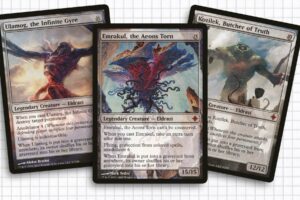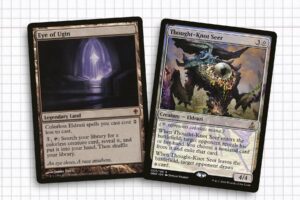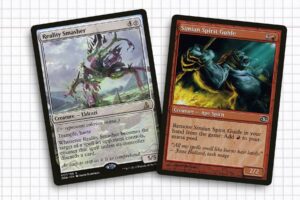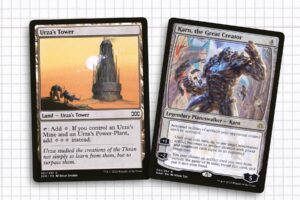The call of the Eldrazi had me, almost immediately. I pulled a copy of Eye of Ugin from an early Worldwake prize pack, likely hoping for a Jace, the Mind Sculptor. At the time, the card made little sense, as no cards had yet been printed with the Eldrazi creature type. And in truth, the entire creature type would be best known for years around its three titans. But from this pool of less than two dozen cards, I developed a kinship with these colorless behemoths which grabbed hold long before it was possible to build a typal deck around them.
From the fascination I developed the Shattergang Brothers Eldrazi deck that I will probably have in some form, long after I have walked away from Magic: the Gathering. Taking roots in the original two trips to Zendikar, the deck looks to honor the power of going colorless. And while the world is finally catching up, as Commander Masters is now promising a colorless Eldrazi deck, that’s not the story that I wanted to tell today.
You see, for a brief period of time in 2016, the Eldrazi were one of the most metagame-defining archetypes that Modern ever faced. A topic that has fallen by the wayside and that no one wants to talk about, yet I’ve always had a fascination with. This is the story of Eldrazi Winter, a period of Modern’s history that was upended by the titanic monster, before ultimately being struck down by the intervention of Wizards of the Coast. I’m here to do my part, chronicle its brief history, and examine the impact it made.

A Tale of Three Titans
In the beginning, the Eldrazi were known for their size. Coming on the scene in 2010’s Rise of the Eldrazi, like Slivers, they felt like something uniquely their own. Colorless creatures whose curve started at eight mana value, so to compensate, the lands Eldrazi Temple and Eye of Ugin were present to help level the playing field. But in truth, prior to 2015’s Battle for Zendikar, the legacy of the Eldrazi was almost entirely encapsulated by the three titans, Kozilek, Butcher of Truth, Ulamog, the Infinite Gyre, and Emrakul, the Aeons Torn. During those years, it was not unusual to see Kozilek or Ulamog as the top end of a Commander deck and Emrakul was an expected factor in the eternal formats. And once Modern came into being, you’d reanimate Emrakul with a Goryo’s Vengeance or pull her Through the Breach. For many years, no one gave a second thought about the non-legendary Eldrazi. Then we returned to Zendikar.

Eye on the Prize
Taking place February 5-7, 2016, Pro Tour Oath of the Gatewatch was a Modern event promoting the second set in the Battle for Zendikar block. Occurring a few weeks after the banning of Splinter Twin and Summer Bloom in Modern, on January 18, 2016, Wizards was looking to refresh the format some and have that new meta on full display at the Pro Tour. Without the Splinter Twin combo looming over Modern, the Death’s Shadow deck was discovered and made its first impact into competitive Magic. So it’s possible that if several teams had tested differently, our take away from this tournament may have still focused on a very different newcomer.
The weekend had three Eldrazi decks premiering at the tournament: Blue/Red Eldrazi, which won the event, a Colorless Eldrazi developed by combined teams from Channel Fireball and Face to Face, and a lone Sultai Eldrazi deck, which also broke into the Top 8. All these decks were using the fast mana of Eye of Ugin and Eldrazi Temple to ramp into threats like giant Endless Ones, Thought-Knot Seer, and Reality Smasher in the first three turns. These threats were protected by Rachet Bomb, Chalice of the Void, and – where possible – Drowner of Hope. Most impressive, Vile Aggregate was compared to Tarmogoyf “but with trample” by the weekend’s winner, Jiachen Tao.
A takeaway from the weekend was that unprepared decks just had no chance against the pace these decks could operate at. All in all, it was a very impressive showing for the archetype, but analysis afterward confirmed that Eldrazi decks represented only 8.2% of the Day One meta, eventually representing 75% of the Top 8. As Patrick Chapin put it:
“Nearly one out of five Eldrazi players actually Top 8’ed the Pro Tour! That’s just ridiculous. For reference, when Luis Scott-Vargas won Pro Tour Berlin with Elf Combo (the last Top 8 to feature six copies of the “broken” deck), Elves was 15.6% of the field.”
As someone who loved the Eldrazi, it was an exciting Pro Tour to watch in real time. Games featuring the archetype would end at lightning pace, only adding to the specter being cast by the eldritch monsters. They would make room for other decks from the weekend to be featured across the rounds. What can I say? I love watching games of Magic where the decisions made on turn three matter on turn eight, but I also love to watch games propelled into the critical turns on turn three. Looking back I think my outlook, that this was going to be a weekend metagame and that format veterans would be able to address the threats within a few weeks, proved to be naive.
Modern Reshaper
Coming out of the Pro Tour, some in the community highlighted the benefits of a top tier deck being “$400.00 for a Manabase plus some Draft trash,” but many others were calling for an emergency ban. Ironic, because the previous emergency banning of Memory Jar occurred after the artifact blew open Extended at Grand Prix Vienna, just after Wizards had a long string of bannings in an effort to correct the game following Combo Winter. Sometimes, history repeats itself. It was correctly identified at the time that the reason why all this was happening was because we were given lands that were meant to allow you to cast eight drops, but were now affecting four drops. Early predictions were that Eldrazi Temple or Eye of Ugin or both would need to go.
It would be about two weeks before “Eldrazi Winter” entered the lexicon and by then, the archetype was getting compared to the late stage Survival of the Fittest metagame, just before it got banned in Legacy in December 2010. During the last half of that year, the Legacy metagame was being decided by an archetypical combo deck, based around Survival of the Fittest. Survival-Reanimator, an aggro deck, Survival-Beatdown, and a control deck in which Survival was paired with Force of Will. Once you reach a state where the field is either the best deck or decks positioning to beat the best deck, players will tend to disengage very quickly.
By the end of February 2016, Modern tournaments held by Star City Games were being overrun with archetypes such as White/Blue Eldrazi, Bant Eldrazi, Blue/Red Eldrazi, and Red/Green Eldrazi, which all occupied about 57% of the Top 32. Over the coming weeks, in the name of format diversity, players were advising that some combination of Eye of Ugin, Eldrazi Temple, and/or Simian Spirit Guide needed to be banned, thus cutting the Eldrazi decks off from their fast mana. This was all mounting as three Modern Grands Prix were forthcoming, the first weekend of March. Ultimately, across that very weekend, Eldrazi decks were 47% of the field. Wizards had already voiced some concern about the direction the Eldrazi were developing in, but now it clear they had created a monster.
I was personally conflicted. It was invigorating to witness an archetype most known for having giant cosmic horrors proving to be a competitive player in one of my then-favorite formats. It was the only time I felt diametrically opposed to the opinions of a large majority of the community. And if I’ve done my job correctly here, I hope it is clear that all of these elements were also solidifying into a format that many people were finding untenable. Regardless, 59 days after their Pro Tour premiere, Eye of Ugin was banned and the archetype was neutered, for the moment.
Where are We Now?
Following the banning of Eye of Ugin, the archetype lost its momentum some, but the damage had already been done and people were now aware of just how good Matter Reshaper, Thought-Knot Seer, and Reality Smasher could be. Within a few years, a prominent Eldrazi Tron deck would come together as Walking Ballista and Karn, the Great Creator were printed. And now it’s a deck that might put a pilot into the Top 16 or Top 8 of a tournament. By all accounts, it is still a factor in the metagame, just not with the same format dominance.
While I am a biased party, and not an established modern expert, I do wonder what Modern would look like if we unbanned Eye of Ugin. From an outsider’s perspective, it would seem that the format has evolved so much in the last seven years, to the point of being unrecognizable. Is it possible that what this deck is capable of isn’t as frightening as it once was? Then again, we’re talking about fast mana. You always ban the fast mana.
Ryan Sainio (he/him) is a Graphic Designer exploring the Commander format and Magic history on a regular basis. Notable decks that value flavorful and fun gameplay over competitively optimized decks include Shattergang Eldrazi, Doran Soul Sisters, and Chatterfang ProsBloom.
MTG Content Creator Awards 2022 nominee: Format Specialty Writing & Excellence in Writing Overall



